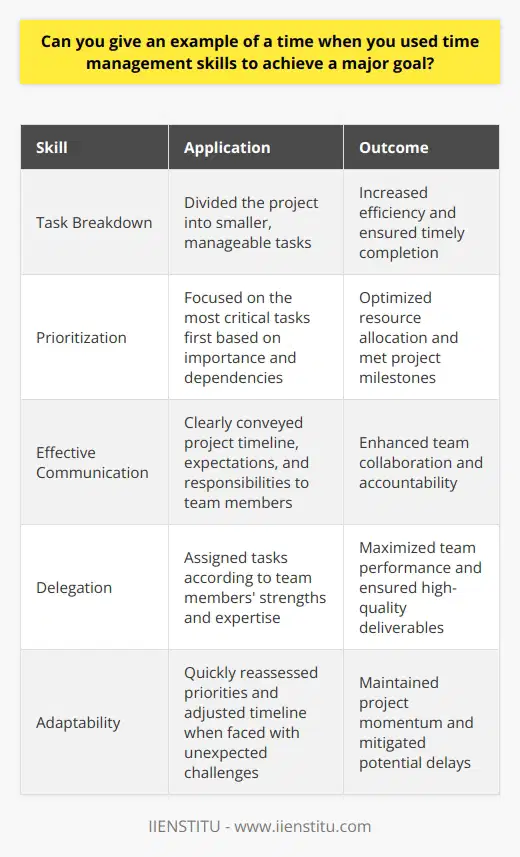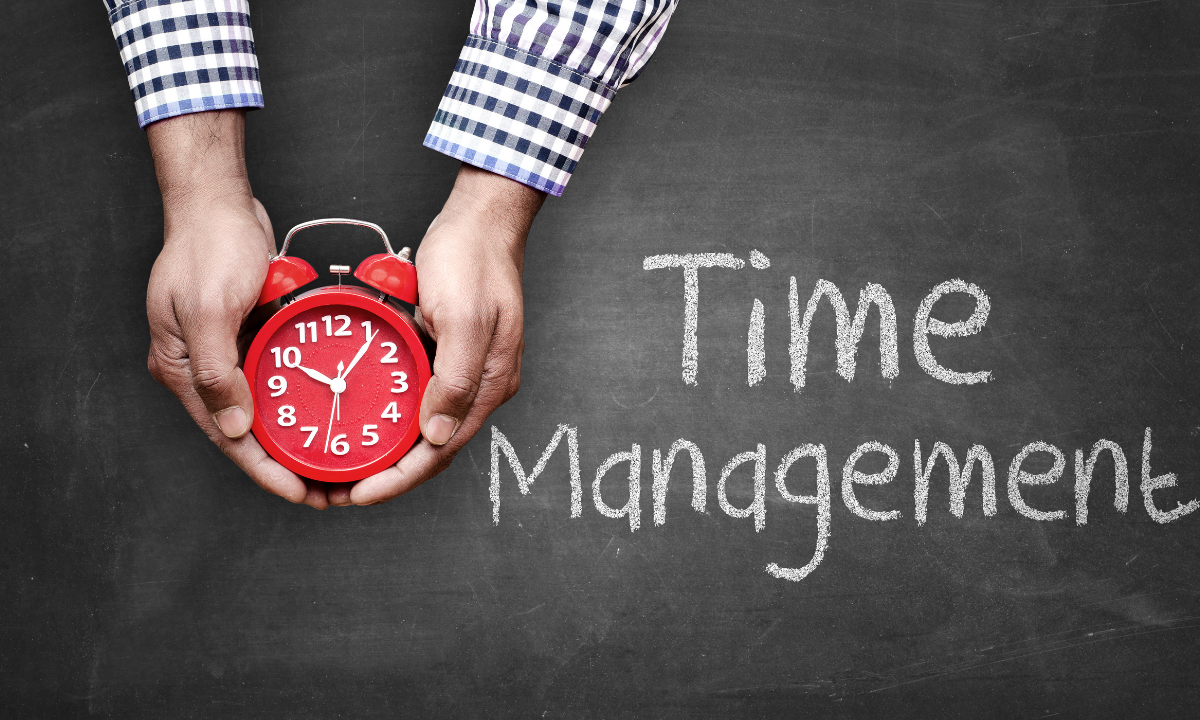
I still remember the day like it was yesterday. I was sitting in a sunlit office, waiting nervously for my name to be called for an interview. Butterflies fluttered wildly in my stomach as I rehearsed answers to potential questions. When I finally sat across from the interviewer, she leaned in with a curious smile and asked, "How did you cultivate your time management skills?" For a moment, my mind raced back through years of juggling responsibilities, deadlines, and the countless strategies I had tried to keep everything on track.
Understanding the Essence of Time Management
Time management, in my experience, isn't just about cramming as many tasks as possible into a day. It's about prioritizing, scheduling, and sometimes even letting go of less critical tasks. Early in my career, I believed that being busy equated to being productive. However, I soon learned that effective time management is more about working smarter than working harder.
My Personal Journey to Mastering Time Management
Growing up in a bustling household, I was the oldest of four siblings. With both parents working full-time, a lot of the household responsibilities fell on my shoulders. From helping my younger siblings with their homework to preparing meals, I had to find a way to balance my schoolwork and home duties.
How To Rate Expertise İn Digital Marketing İnterview Question
Technologies For Enhancing Supply Chain Visibility İnterview Strategies
One vivid memory stands out from my high school days. It was the week before finals, and I was swamped with projects, studying, and my part-time job at the local library. I felt overwhelmed and on the brink of burnout. That's when my literature teacher, Mrs. Thompson, pulled me aside and shared some wisdom. She said, "Time is like a river—it keeps flowing regardless of our actions. But if you learn to navigate it, you can reach your destination smoothly."
Interview Question: How Has Time Management Impacted Your Personal Growth?
Interview Question: How Did You Improve a Digital Marketing ROI?
Inspired, I began exploring different time management techniques. I started with simple to-do lists, jotting down everything I needed to accomplish each day. Seeing tasks written out helped me visualize my workload and prioritize accordingly.
Strategies That Shaped My Time Management Skills
Over the years, I've tried various methods to improve my efficiency. Here are some strategies that have made a significant impact:
1- The Eisenhower Matrix: This tool helped me categorize tasks based on urgency and importance. By dividing tasks into four quadrants, I could focus on what truly mattered.
2- Time Blocking: I began allocating specific blocks of time to particular tasks or activities. This not only improved my focus but also reduced the time wasted on deciding what to do next.
3- Setting SMART Goals: Ensuring that my goals were Specific, Measurable, Achievable, Relevant, and Time-bound provided clarity and direction.
4- Embracing Technology: Utilizing apps like Trello and Google Calendar streamlined my scheduling and enabled me to set reminders for critical deadlines.
5- Regular Reflection: At the end of each week, I spent time reviewing what worked and what didn't. This practice allowed me to adjust my strategies and continuously improve.
Overcoming Challenges Along the Way
Of course, the path wasn't always smooth. In my first corporate job, I faced a significant challenge when assigned to lead a project with a tight deadline. Despite my best efforts, I found myself staying late at the office, struggling to keep up. It became clear that my current approach wasn't sufficient.
Seeking advice, I turned to a mentor in the company, Mr. Alvarez. He introduced me to the concept of delegate and elevate. He said, "You can't do everything yourself. Trust your team, delegate tasks, and focus on what only you can do." Taking his advice to heart, I began delegating appropriate tasks to team members. This not only lightened my load but also empowered my colleagues, leading to a more collaborative and efficient team environment.
Why Interviewers Ask About Time Management Skills
When interviewers pose the question, "How did you cultivate your time management skills?", they're looking to understand several things:
Self-awareness: Do you recognize the importance of time management in your professional growth?
Initiative: Have you actively sought out methods to improve?
Can you briefly explain the process of improving your time management skills?
What strategies did you use to develop your time management abilities?
Can you share the journey of honing your skills in time management?
What methods did you deploy in order to foster your time-saving abilities?
How did you go about refining your capacity to manage time effectively?
What approach did you adopt to cultivate the proficiency in managing time effectively?
In your experience, how did you enhance your skill set in managing time well?
Please describe your tactics to improve the skills necessary for effective time management.
Can you tell me how you basically evolved your competence for managing time?
What were your techniques or strategies used to better your skills in time management?
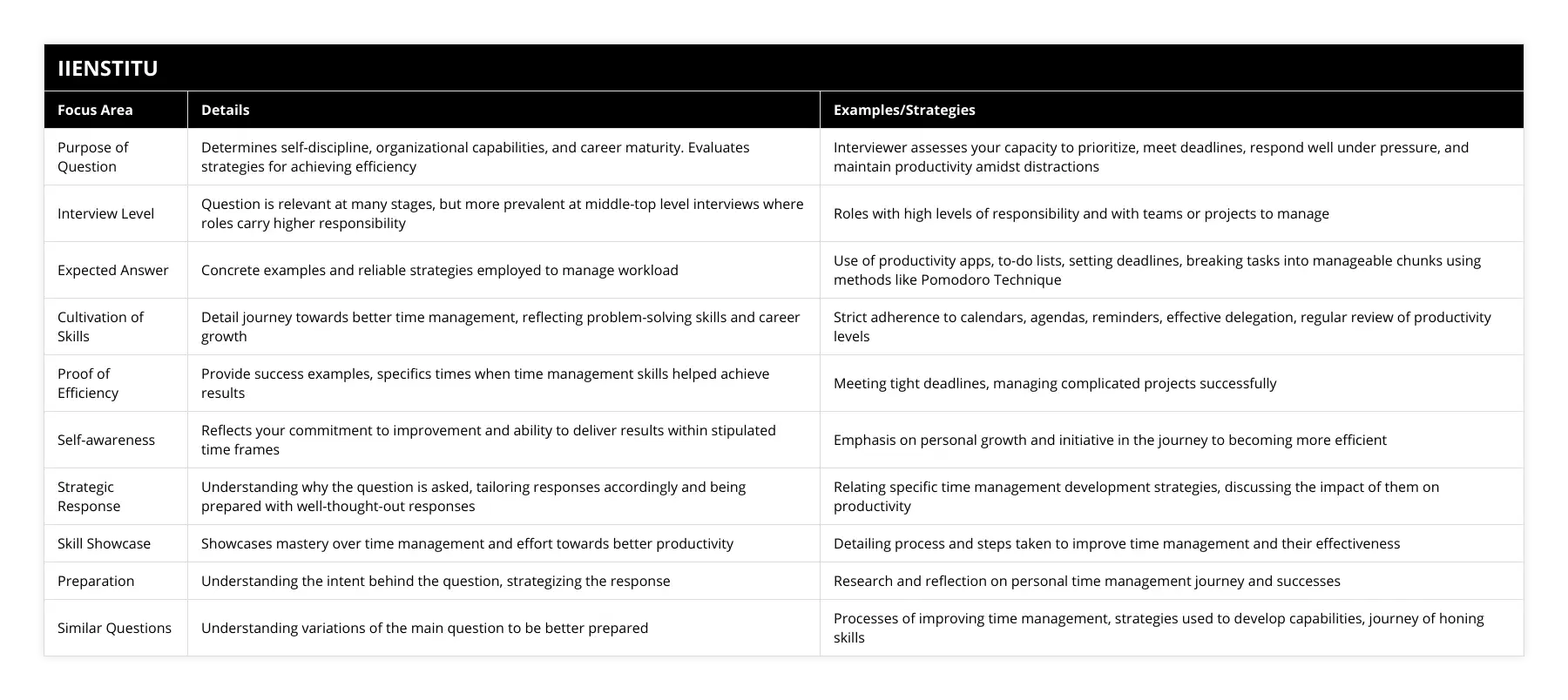
Application: How have you implemented these skills in real-world scenarios?
Impact: What positive outcomes have resulted from your effective time management?
They want to see that you're not just aware of time management theories but that you've applied them successfully, leading to tangible benefits in your previous roles.
Crafting an Effective Response
So, how should you respond to make a lasting impression? Here's a roadmap:
1- Start with a Personal Anecdote: Share a specific experience where time management was crucial.
2- Highlight the Strategies Used: Explain the techniques you employed and why you chose them.
3- Emphasize the Outcomes: Detail the positive results that stemmed from your actions.
4- Reflect on Lessons Learned: Discuss how these experiences have shaped your approach to time management moving forward.
Sample Answer
"During my tenure at XYZ Corporation, I was tasked with managing simultaneous marketing campaigns for two major clients. Realizing the complexity, I knew I needed an effective strategy. I implemented time blocking in my calendar to dedicate focused periods to each project. I also used the Eisenhower Matrix to prioritize daily tasks.
As a result, both campaigns were delivered on time and exceeded client expectations, leading to a 15% increase in repeat business. This experience reinforced the importance of structured time management and has become a cornerstone of my professional approach."
The Broader Impacts of Good Time Management
Effective time management doesn't just benefit individual performance; it has ripple effects throughout an organization. Some of these include:
Enhanced Team Productivity: When team members manage their time well, projects move forward smoothly.
Improved Work-Life Balance: Efficient use of time can reduce overtime, leading to better overall well-being.
Higher Quality Work: Focused efforts often result in superior outcomes.
Stress Reduction: Knowing how to manage time can alleviate the pressure of tight deadlines.
Personal Growth and Time Management
On a personal level, mastering time management has allowed me to pursue hobbies, spend quality time with family, and even volunteer in my community. For instance, I started mentoring high school students on weekends, guiding them on college applications and career choices. This was only possible because I had learned to balance my professional and personal commitments effectively.
Time Management Across Different Scenarios
Time management is a universal skill that applies to various situations, from daily tasks to significant life events. For example, when I needed to relocate for work, writing a reassignment request letter was a meticulous process. I had to gather tips and information to ensure the letter was professional and persuasive. This required careful planning and time allocation to research company policies, articulate my reasons clearly, and submit the request within the necessary timelines.
Tips for Cultivating Your Own Time Management Skills
If you're looking to enhance your time management abilities, here are some actionable steps:
Identify Your Peak Productivity Times: Some people are morning larks, others are night owls. Schedule high-priority tasks when you're most alert.
Set Clear Boundaries: Establish limits to avoid overcommitting, such as not checking emails after a certain hour.
Utilize the Two-Minute Rule: If a task takes less than two minutes, do it immediately.
Batch Similar Tasks Together: Grouping tasks can reduce the mental load and increase efficiency.
Schedule Downtime: Rest is crucial. Underlined rest periods can prevent burnout and maintain high performance.
Incorporating Feedback and Continuous Improvement
Being open to feedback has been vital in my journey. After completing projects, I often seek input from colleagues and supervisors. This has helped me identify blind spots and areas for improvement. For instance, a colleague once pointed out that my fixation on details sometimes delayed project timelines. Recognizing this, I worked on balancing thoroughness with efficiency.
Recognizing the Human Element
It's important to acknowledge that we're all human. There are days when, despite our best efforts, things don't go as planned. Italicized, I've learned to be gentle with myself during such times. Instead of dwelling on setbacks, I focus on solutions and adjust my strategies accordingly.
Conclusion
Cultivating time management skills is an ongoing process. It's about self-awareness, experimentation, and adaptation. When faced with the interview question, "How did you cultivate your time management skills?", embracing authenticity and sharing your unique journey can set you apart.
Remember, effective time management isn't just a professional asset; it's a life skill that enhances all aspects of our daily existence. As time philosopher Alan Lakein aptly said, "Time = Life; therefore, waste your time and waste your life, or master your time and master your life."
References
Allen, D. (2001). Getting Things Done: The Art of Stress-Free Productivity. Penguin Books.
Covey, S. R. (1989). The 7 Habits of Highly Effective People. Free Press.
Lakein, A. (1973). How to Get Control of Your Time and Your Life. New American Library.
Tracy, B. (2007). Eat That Frog!: 21 Great Ways to Stop Procrastinating and Get More Done in Less Time. Berrett-Koehler Publishers.
Key Takeaways:
Effective time management is about prioritizing and working smarter.
Personal experiences can provide powerful examples during interviews.
Strategies like the Eisenhower Matrix, time blocking, and SMART goals are invaluable.
Continuous reflection and adaptation are crucial for ongoing improvement.
Balancing professional and personal life leads to overall well-being.
Similar Interview Questions to Prepare For
Can you briefly explain the process of improving your time management skills?
What strategies did you use to develop your time management abilities?
Can you share the journey of honing your skills in time management?
What methods did you deploy to foster your time-saving abilities?
How did you go about refining your capacity to manage time effectively?
What approach did you adopt to cultivate proficiency in managing time?
In your experience, how did you enhance your skill set in managing time well?
Please describe your tactics to improve skills necessary for effective time management.
Can you tell me how you basically evolved your competence for managing time?
What were your techniques or strategies used to better your skills in time management?
By preparing thoughtful responses to these questions, you can showcase your time management prowess and stand out as a candidate ready to take on challenges efficiently.
Note: The experiences and strategies shared are based on personal journeys and insights. Time management is a personal process, and what works for one may differ for another. The key is to find techniques that align with your unique circumstances and goals.
Frequently Asked Questions
How do you prioritize your tasks?
Effective Task Prioritization Techniques
When it comes to prioritizing my tasks, I always start by making a comprehensive to-do list. This helps me visualize everything that needs to be done and ensures nothing slips through the cracks. Once I have my list, I assess each task based on urgency and importance.
Urgency vs. Importance
I've learned that distinguishing between urgent and important tasks is crucial. Urgent tasks demand immediate attention, while important tasks contribute to long-term goals. I strive to tackle important tasks first, even if they're not necessarily urgent. This strategy helps me stay focused on the big picture and avoid getting caught up in less consequential matters.
Breaking Down Large Projects
When faced with a large project, I break it down into smaller, manageable steps. This makes the overall task less daunting and allows me to make steady progress. I set milestones for each step and celebrate small victories along the way. It's a great motivation booster!
Flexibility and Adaptability
While having a plan is essential, I also remain flexible. Priorities can shift unexpectedly, and new tasks may arise. When this happens, I reassess my list and make adjustments as needed. Being adaptable has helped me navigate challenging situations and deliver results consistently.
Communication is Key
Lastly, I believe in the power of communication. I regularly touch base with my team and supervisors to ensure alignment on priorities. This helps prevent misunderstandings and keeps everyone on the same page.
In summary, my approach to task prioritization involves creating a comprehensive list, distinguishing between urgent and important tasks, breaking down large projects, staying flexible, and maintaining open communication. By following these strategies, I'm able to effectively manage my workload and deliver high-quality results.
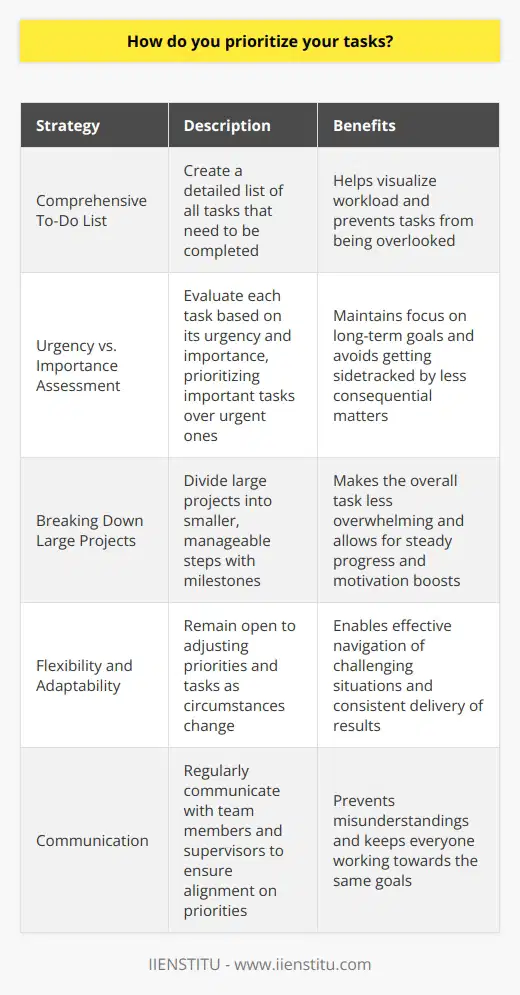
What strategies do you use to manage your time effectively?
I have found that using a combination of strategies helps me manage my time effectively. First, I prioritize my tasks based on urgency and importance. This allows me to focus on the most critical tasks first.
Planning Ahead
I also make sure to plan ahead by breaking larger projects into smaller, manageable steps. By setting deadlines for each step, I can ensure steady progress and avoid last-minute rushes.
Minimizing Distractions
To stay focused, I try to minimize distractions. I silence my phone notifications and close unnecessary browser tabs when working on important tasks. Taking short breaks helps me recharge and maintain productivity throughout the day.
Using Time-Tracking Tools
I've found time-tracking tools incredibly useful for monitoring how I spend my time. Seeing a breakdown of where my hours go motivates me to use my time more wisely.
Delegating When Possible
Finally, I'm not afraid to delegate tasks when appropriate. Recognizing when to ask for help allows me to manage my workload more efficiently.
By combining these strategies, I'm able to stay organized, meet deadlines, and achieve my goals. Time management is a skill I'm always working to improve.

How do you handle competing deadlines?
Prioritizing Tasks
When faced with competing deadlines, I first assess the urgency and importance of each task. I consider the potential impact on the company and client relationships. Then, I prioritize accordingly, focusing on the most critical projects first.
Communicating with Stakeholders
Open communication is key. I keep my manager and relevant stakeholders informed about my progress and any challenges I encounter. If I foresee difficulty meeting a deadline, I proactively discuss alternative solutions or ask for guidance on priority adjustments.
Breaking Down Projects
To manage multiple deadlines effectively, I break larger projects into smaller, manageable tasks. This helps me stay organized and maintain a steady workflow. I set personal milestones to ensure I'm on track and making consistent progress.
Leveraging Time Management Techniques
I rely on proven time management techniques like the Pomodoro method and time blocking. These strategies help me maintain focus, minimize distractions, and maximize my productivity. I also use project management tools to keep tasks organized and easily accessible.
Collaborating with Colleagues
When necessary, I collaborate with colleagues to delegate tasks or seek assistance. By leveraging the strengths of my team members, we can tackle competing deadlines more efficiently. Collaboration fosters a supportive work environment and ensures high-quality results.
Adapting to Changes
I understand that priorities can shift unexpectedly. When faced with changes, I remain flexible and adapt my approach accordingly. I quickly reassess my tasks, adjust my timeline, and communicate any updates to the relevant parties.

Can you give an example of a time when you had to manage a heavy workload?
During my previous role as a project manager, I faced a challenging period where I had to manage multiple projects simultaneously. It was a demanding time, but I approached it with a positive attitude and a well-organized plan.
Prioritizing Tasks
I carefully evaluated each project's deadlines and requirements, prioritizing them based on urgency and importance. This helped me focus on the most critical tasks first, ensuring that I met all the essential milestones.
Effective Communication
I maintained clear and frequent communication with my team members and stakeholders. Regular updates and meetings kept everyone informed about the progress and any potential issues, fostering a collaborative environment.
Time Management Strategies
To optimize my productivity, I employed various time management techniques, such as the Pomodoro Technique and time-blocking. These strategies allowed me to dedicate focused attention to each task, minimizing distractions and increasing efficiency.
Adaptability and Flexibility
Throughout the process, I remained adaptable and flexible. When unexpected challenges arose, I quickly adjusted my approach and found creative solutions to keep the projects moving forward.
By staying organized, communicating effectively, and maintaining a proactive mindset, I successfully managed the heavy workload and delivered all projects on time. This experience strengthened my ability to handle pressure and boosted my confidence in tackling complex situations.

How do you ensure that you meet your deadlines?
I have developed a system to ensure that I consistently meet my deadlines. This approach has proven effective throughout my career.
Prioritizing Tasks
I begin by carefully reviewing my workload and prioritizing tasks based on their urgency and importance. This helps me focus on the most critical assignments first.
Breaking Down Projects
For larger projects, I break them down into smaller, manageable steps. This allows me to tackle the work in stages and maintain a steady progress.
Setting Personal Deadlines
I set my own deadlines for each task, usually a few days before the official due date. This buffer gives me flexibility to handle unexpected challenges.
Communicating with Team Members
I maintain open lines of communication with my colleagues and supervisors. If I foresee any issues, I proactively discuss them and collaborate on solutions.
Utilizing Time Management Tools
I rely on tools like calendars, task lists, and project management software to stay organized. These help me track my progress and ensure nothing falls through the cracks.
Staying Focused and Motivated
I minimize distractions and maintain a positive attitude, even under pressure. I remind myself of the importance of meeting deadlines for the success of the team and company.
By following this systematic approach, I have consistently met my deadlines and contributed to the achievement of organizational goals.
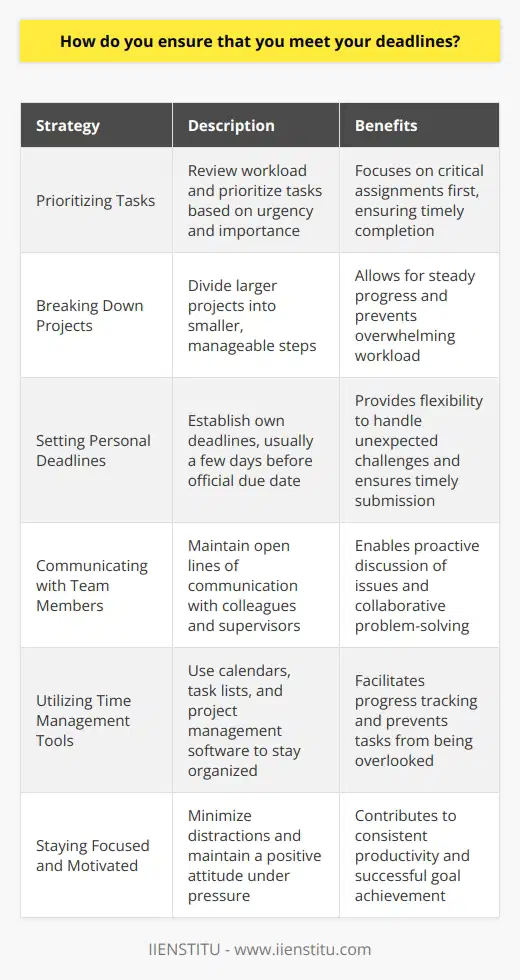
What tools or techniques do you use to stay organized?
As someone who values organization, I rely on a combination of tools and techniques to stay on top of my tasks and responsibilities.
Digital Tools
I'm a big fan of using digital tools to keep myself organized. One of my go-to apps is Trello, which allows me to create boards for different projects and tasks. I love how visual it is and how easy it is to drag and drop cards between lists. Another tool I use daily is Google Calendar. I block out time for specific tasks and meetings, which helps me stay focused and avoid overbooking myself.
Analog Methods
While digital tools are great, I also appreciate the value of analog methods. I always carry a small notebook with me to jot down ideas, reminders, and to-do lists. There's something satisfying about physically crossing items off a list. I also use a whiteboard in my home office to map out bigger projects and visualize my progress.
Prioritization and Time Management
Staying organized is not just about the tools you use, but also about how you manage your time and priorities. I start each day by identifying my top three priorities and ensuring I allocate enough time to work on them. I also use the Pomodoro Technique, working in focused 25-minute intervals with short breaks in between, to maintain my productivity throughout the day.
Regular Review and Reflection
Finally, I believe in the importance of regular review and reflection. Each week, I take some time to review my progress, update my to-do lists, and make adjustments as needed. This helps me stay on track and ensures that I'm making progress towards my goals.
By combining digital tools, analog methods, prioritization techniques, and regular reflection, I've created a system that keeps me organized and allows me to be my most productive self.
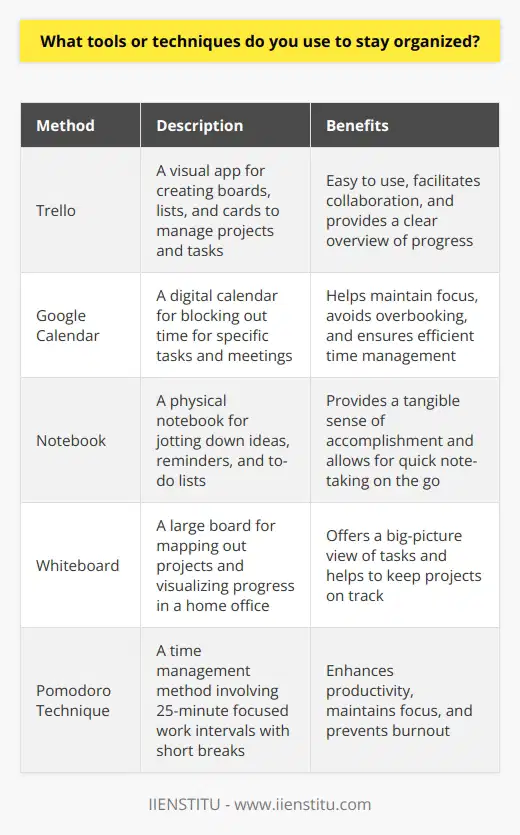
How do you handle interruptions or unexpected tasks?
When it comes to handling interruptions or unexpected tasks, I always try to remain calm and focused. I understand that in any work environment, unexpected situations can arise that require immediate attention. In such cases, I quickly assess the urgency and importance of the new task and determine how it fits into my current priorities.
Prioritizing Tasks
If the unexpected task is critical and time-sensitive, I prioritize it and communicate with my team or supervisor about adjusting my current workload. I believe in being flexible and adaptable to ensure that the most pressing matters are addressed promptly.
Maintaining Focus
When interrupted, I make a mental note of where I left off in my current task. This helps me quickly resume my work once the interruption is handled, minimizing any loss of productivity. I find that staying organized and having a clear plan allows me to navigate interruptions more efficiently.
Communication is Key
I also believe in the importance of clear communication during unexpected situations. I keep my team informed about any changes in my priorities and provide updates on the progress of the unexpected task. This ensures that everyone is on the same page and can adjust their own work accordingly.
Learning from Interruptions
Lastly, I view interruptions and unexpected tasks as opportunities for growth and learning. Each new challenge presents a chance to develop problem-solving skills, adaptability, and resilience. By embracing these situations with a positive attitude, I can continuously improve my ability to handle future interruptions effectively.
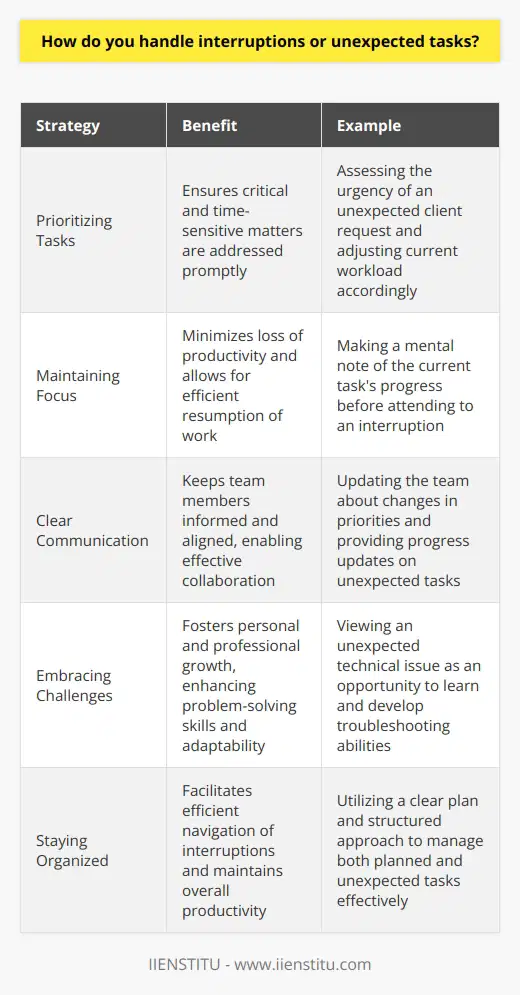
How do you balance short-term and long-term tasks?
Balancing short-term and long-term tasks is all about effective prioritization and time management. I always start by identifying urgent tasks that require immediate attention and have significant consequences if not completed on time.
Prioritizing Tasks
Next, I assess the importance of each task in relation to my long-term goals. This helps me allocate my time and resources appropriately, ensuring that I make steady progress towards my objectives.
Breaking Down Long-Term Tasks
When faced with a complex, long-term project, I break it down into smaller, manageable steps. This allows me to work on it consistently, without neglecting my short-term responsibilities.
Flexibility and Adaptability
I understand that priorities can change, so I remain flexible and adaptable. If a new urgent task arises, I reassess my priorities and adjust my schedule accordingly.
Effective Communication
Effective communication is key when balancing short-term and long-term tasks. I keep my team and stakeholders informed about my progress and any potential challenges, ensuring everyone is on the same page.
In my previous role, I successfully balanced multiple short-term deadlines while working on a long-term strategy project. By prioritizing tasks, breaking down the project into smaller steps, and communicating effectively with my team, I delivered all my short-term tasks on time and made significant progress on the long-term project.
Balancing short-term and long-term tasks requires a combination of prioritization, adaptability, and effective communication. By mastering these skills, I can consistently deliver results while working towards my long-term goals.
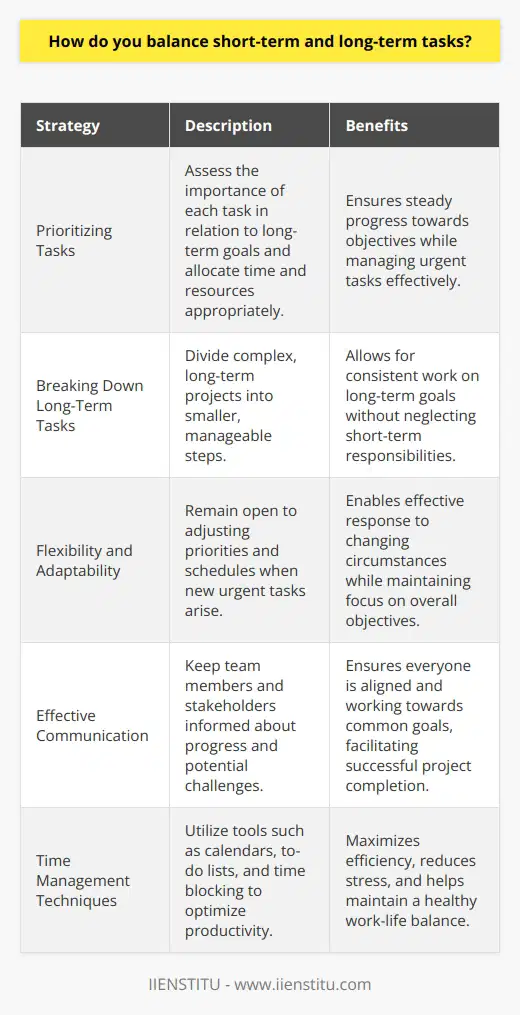
Can you describe a time when you had to adapt your time management strategies?
In my previous role as a project manager, I faced a challenging situation where our team's workload suddenly increased due to a new client's urgent requirements. To adapt, I quickly reassessed our priorities and delegated tasks based on each team member's strengths and availability. This allowed us to focus on the most critical tasks first.
Communicating with the Team
I scheduled a team meeting to discuss the changes in our timeline and brainstorm solutions. By involving everyone in the decision-making process, we were able to identify potential roadblocks and develop a revised plan that accounted for the new deadlines. Open communication was key to ensuring everyone understood their roles and felt supported.
Leveraging Technology
To streamline our efforts, I introduced a new project management tool that helped us track progress in real-time. This software allowed team members to update their status, share files, and collaborate more efficiently. By embracing technology, we were able to save time and stay organized despite the increased workload.
Staying Flexible
Throughout the project, I remained flexible and open to adjusting our strategies as needed. When unexpected issues arose, I quickly assessed the situation and made necessary changes to keep us on track. This adaptability was crucial to successfully navigating the challenges we faced.
In the end, by adapting our time management strategies and working collaboratively, we were able to deliver the project on time and exceed our client's expectations. This experience taught me the importance of being proactive, communicative, and flexible in the face of change.

How do you avoid procrastination?
I've found that the key to avoiding procrastination is to break tasks into smaller, manageable steps. By focusing on one small piece at a time, the overall project doesn't seem as daunting or overwhelming. This helps me stay motivated and make steady progress.
Prioritize and Plan
Every morning, I make a to-do list and prioritize my tasks for the day. I always tackle the most important or challenging items first while my energy and focus are at their peak. Having a clear plan keeps me on track.
Eliminate Distractions
I'm easily distracted, so I take steps to limit interruptions during my work time. I silence my phone notifications, close unnecessary browser tabs, and let others know when I need uninterrupted focus time to be productive. Reducing distractions helps me concentrate.
Take Breaks
Paradoxically, I find taking regular short breaks actually helps me procrastinate less. Stepping away from my desk to stretch, grab a healthy snack, or chat with a coworker provides a mental reset. I return feeling refreshed and ready to dive back in.
Use Positive Self-Talk
If I catch myself procrastinating, I use positive self-talk to get back on task. Instead of beating myself up, I remind myself of my goals and capabilities. Phrases like "You've got this!" or "Just get started" help me overcome inertia and take action.
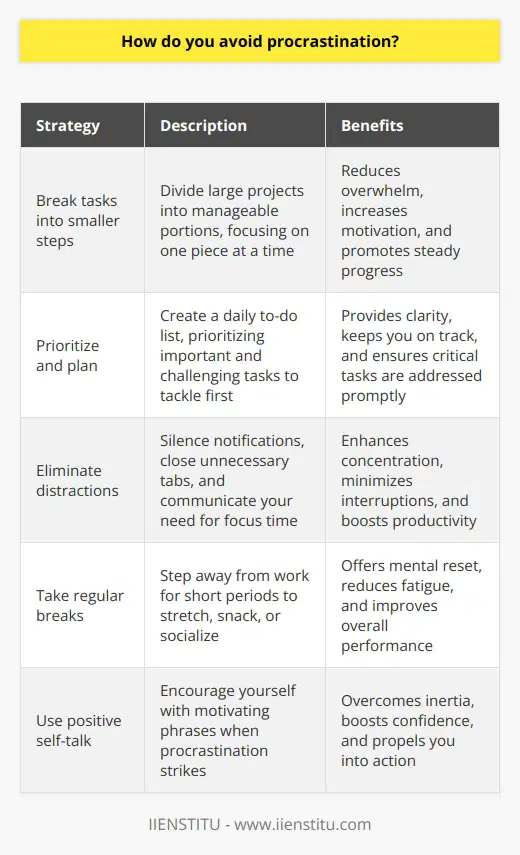
What do you do when you feel overwhelmed with your workload?
When I feel overwhelmed with my workload, I take a step back and prioritize my tasks. I find that creating a to-do list helps me focus on the most critical items first.
Communicate with Your Team
If the workload becomes unmanageable, I reach out to my colleagues and supervisor for support. Collaborating with others can lighten the load and provide fresh perspectives on how to tackle challenges.
Practice Self-Care
During particularly stressful periods, I make sure to take care of myself. Taking short breaks throughout the day to stretch, hydrate, and clear my mind helps me maintain a positive outlook and stay productive.
Learn from Experience
I once faced a tight deadline for a project that required input from multiple departments. By breaking the project down into smaller, manageable tasks and delegating responsibilities, we successfully met the deadline without compromising quality.
Stay Organized and Focused
Ultimately, I believe that staying organized, communicating effectively, and maintaining a healthy work-life balance are key to managing a heavy workload. By implementing these strategies, I can remain calm under pressure and deliver high-quality work consistently.
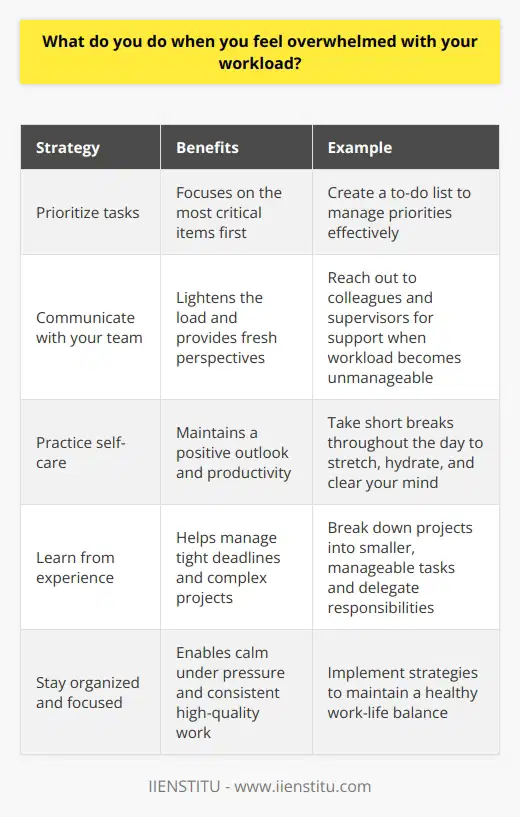
How do you determine which tasks are most important?
When determining which tasks are most important, I first consider the deadlines and potential impact of each task. Tasks with immediate deadlines or those that significantly affect the company's bottom line take priority.
Aligning with Company Goals
I also evaluate how each task aligns with the overall goals and objectives of the company. I prioritize tasks that directly contribute to achieving these goals, as they have the greatest long-term value.
Collaboration and Communication
Effective communication with my team and supervisors is crucial in prioritizing tasks. I actively seek input from others to understand which tasks they consider most pressing and why.
By collaborating with colleagues, I gain a broader perspective on the relative importance of different tasks. This helps me make more informed decisions when prioritizing my workload.
Adaptability and Flexibility
I understand that priorities can shift unexpectedly in a fast-paced work environment. I remain adaptable and flexible, ready to adjust my priorities when necessary to meet changing demands.
By staying organized and maintaining a clear understanding of my responsibilities, I can quickly reprioritize tasks as needed. This ensures that I consistently focus on the most critical tasks, even in the face of unexpected challenges.
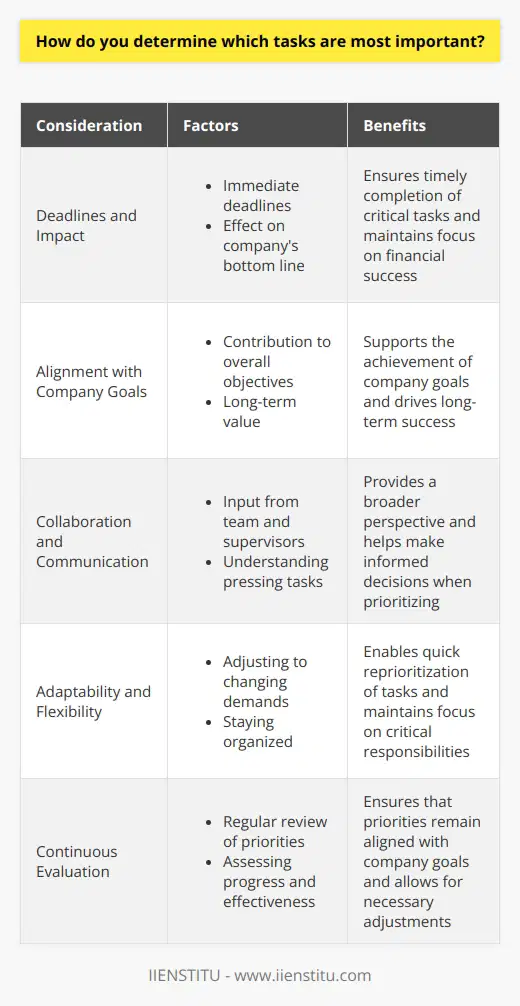
How do you handle tasks that take longer than expected?
When faced with tasks that take longer than expected, I approach the situation with a positive attitude and proactive mindset. I start by breaking down the task into smaller, manageable steps. This allows me to identify potential roadblocks and develop a realistic timeline for completion.
Communicating with the Team
I believe in open communication with my team and supervisors. If I anticipate delays, I promptly inform relevant stakeholders. By keeping everyone in the loop, we can collaboratively adjust priorities and manage expectations.
Utilizing Time Management Techniques
To stay on track, I employ various time management techniques. I prioritize tasks based on urgency and importance. I also set aside dedicated focus time to minimize distractions and maximize productivity. By working smarter, not harder, I can often make up for lost time.
Leveraging Resources and Expertise
When faced with challenging tasks, I'm not afraid to ask for help. I leverage the expertise of my colleagues and seek guidance when needed. By collaborating with others, I can often find creative solutions to overcome obstacles and expedite the process.
Learning and Adapting
I view every challenge as an opportunity for growth. When tasks take longer than expected, I reflect on the reasons why. I learn from my experiences and adapt my approach for future projects. By continuously improving my skills and processes, I become better equipped to handle unexpected delays.
At the end of the day, I focus on delivering high-quality work, even if it takes a bit longer than initially planned. I believe that by staying organized, communicating effectively, and maintaining a positive attitude, I can successfully navigate tasks that take longer than expected.
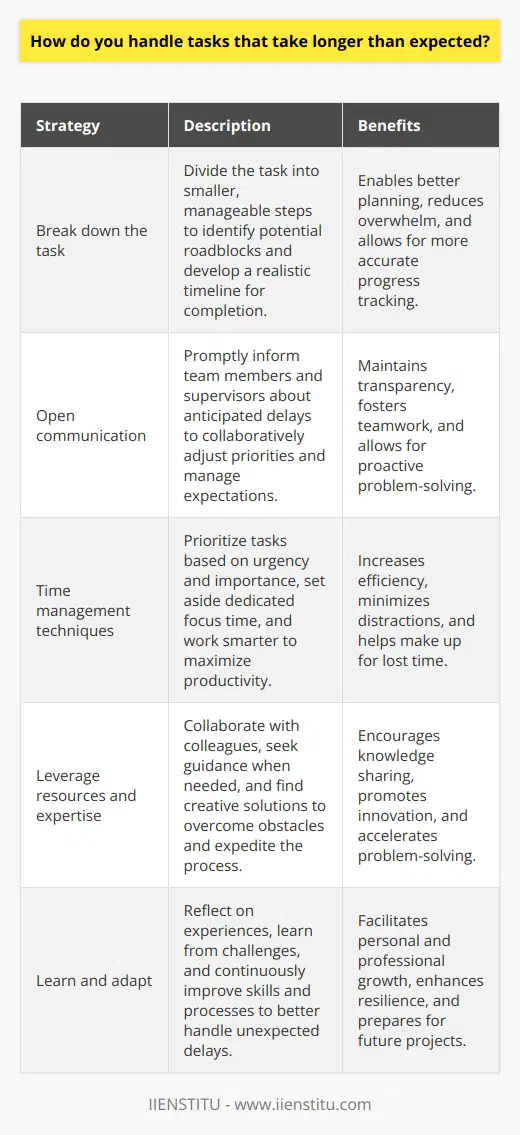
What do you do when you have downtime between tasks?
When I have downtime between tasks, I use it as an opportunity for personal and professional growth. I believe in making the most of every moment, so I try to be productive even during lulls in my workday.
Catching Up on Industry News and Trends
I often use downtime to catch up on the latest industry news, trends, and best practices. By staying informed, I can bring fresh insights and ideas to my work. I subscribe to relevant newsletters, blogs, and podcasts that I can easily check during breaks.
Learning New Skills
Downtime is also a great chance to expand my skill set. Whether it's watching a quick tutorial video, reading an article on a new technique, or practicing a skill, I'm always looking to learn and improve. Just recently, I used some extra time to teach myself a few Excel shortcuts that have already come in handy!
Organizing and Planning
If I have a bit more downtime, I like to get organized and plan ahead. I'll review my to-do list, prioritize tasks, and break down bigger projects into manageable steps. By having a clear roadmap, I can dive back into work feeling focused and prepared.
Overall, I see downtime as a gift - a chance to recharge, learn something new, and set myself up for success. By using slow periods wisely, I'm able to stay energized, engaged, and ready to tackle whatever challenges come my way.
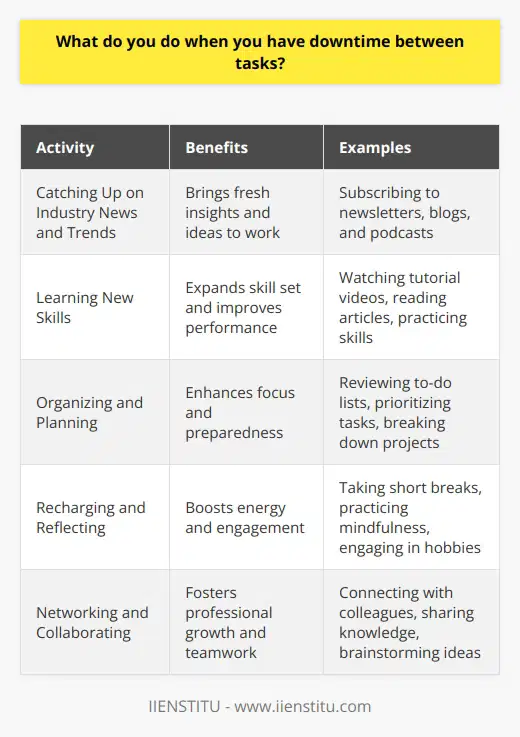
How do you ensure that you are making the best use of your time?
I ensure that I'm making the best use of my time by prioritizing tasks and setting realistic goals. Every morning, I create a to-do list and assign priorities to each item. This helps me focus on the most critical tasks first.
Time Blocking
I use time blocking to allocate specific time slots for different activities. For example, I might dedicate 9 am to 11 am for deep work on a project, then take a short break before moving on to the next task. Time blocking keeps me focused and prevents me from getting sidetracked.
Minimizing Distractions
To make the most of my time, I try to minimize distractions. I turn off notifications on my phone and close unnecessary tabs on my computer. If I'm working on a challenging task, I'll put on noise-canceling headphones to help me concentrate.
Regular Breaks
Taking regular breaks is crucial for maintaining productivity. I use the Pomodoro Technique, where I work for 25 minutes, then take a 5-minute break. After four Pomodoros, I take a longer break of 15-20 minutes. These breaks help me recharge and come back to my work with fresh eyes.
Reflecting and Adjusting
At the end of each day, I reflect on how I spent my time. I ask myself if I achieved my goals and if there are areas where I could improve. If I notice that I'm consistently struggling with certain tasks, I'll try to find ways to streamline my process or break the task down into smaller, more manageable steps.
By prioritizing, minimizing distractions, taking breaks, and reflecting on my progress, I ensure that I'm making the best use of my time. It's an ongoing process, but I find that these strategies help me stay productive and achieve my goals.
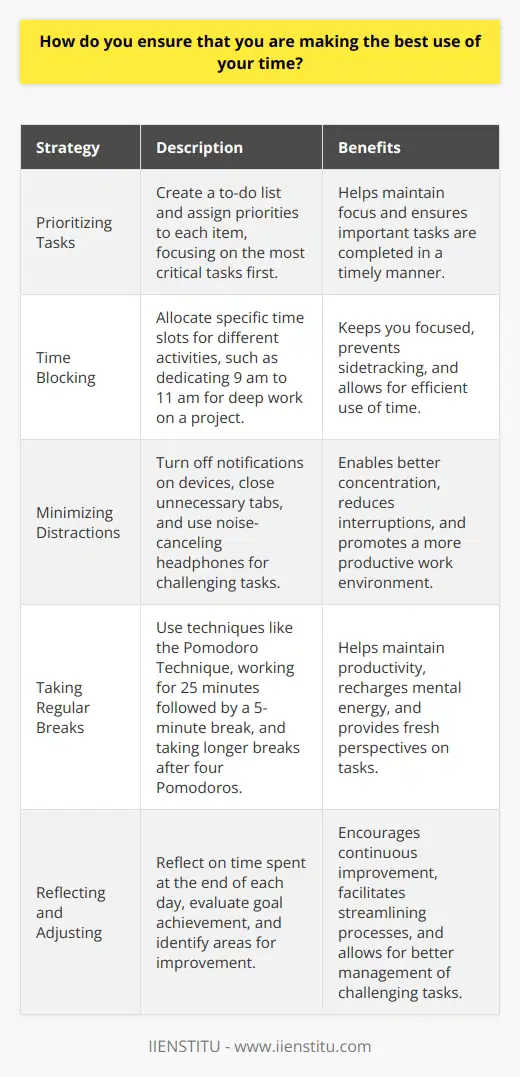
Can you describe a time when you had to prioritize tasks for a team?
As a project manager, I've often had to prioritize tasks for my team. One particular instance stands out in my mind.
The Situation
We were working on a tight deadline for a client's website launch. There were numerous tasks to complete, from coding to content creation.
Assessing Priorities
I sat down with my team and we went through each task, determining which were critical for the launch and which could wait. We considered dependencies between tasks and the time required for each.
Creating a Plan
Based on our assessment, I created a prioritized task list. We would focus on the critical tasks first, then move on to the less urgent ones. I assigned each task to a team member based on their skills and workload.
Communicating and Adjusting
I communicated the plan to the team and made sure everyone understood their responsibilities. As we worked, I regularly checked in with each team member to see how they were progressing. When unexpected issues arose, we adjusted our priorities as needed to stay on track.
In the end, thanks to careful prioritization and a dedicated team effort, we launched the website on time and the client was thrilled. This experience taught me the importance of assessing priorities, creating a clear plan, and staying flexible in the face of challenges.

How do you handle tasks that you find challenging or unenjoyable?
When faced with challenging or unenjoyable tasks, I try to break them down into smaller, manageable steps. This helps me stay focused and motivated, even if the overall project seems daunting. I also remind myself that every task, no matter how difficult, is an opportunity to learn and grow.
Staying Positive
I find that maintaining a positive attitude is key when dealing with unenjoyable tasks. Instead of dwelling on the negative aspects, I focus on the benefits of completing the task, such as gaining new skills or contributing to the team's success. This mindset shift makes the work feel more meaningful and rewarding.
Seeking Support
When I encounter a particularly challenging task, I'm not afraid to ask for help or guidance from my colleagues or supervisors. Collaborating with others often leads to creative solutions and makes the work more enjoyable. I also find that discussing my progress and challenges with others helps me stay accountable and motivated.
Embracing the Challenge
Ultimately, I view challenging tasks as opportunities to push myself out of my comfort zone and develop new abilities. By embracing the discomfort and focusing on personal growth, I'm able to approach even the most unenjoyable tasks with a sense of purpose and determination. This mindset has helped me tackle difficult projects in the past and has contributed to my overall professional development.
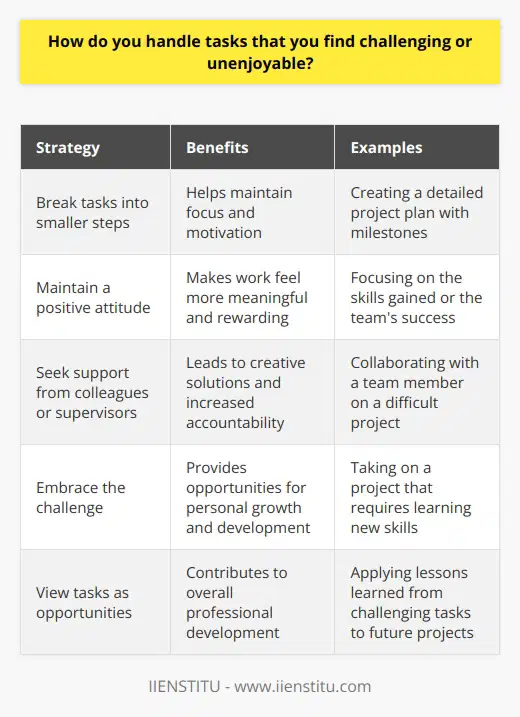
How do you stay focused and avoid distractions?
I stay focused and avoid distractions by following a few key strategies that I've developed over the years. First and foremost, I prioritize my tasks and create a clear plan of action for each day.
Setting Goals and Priorities
Every morning, I take a few minutes to review my goals and determine the most important tasks to tackle. This helps me stay focused on what matters most and avoid getting sidetracked by less critical activities.
Minimizing Distractions
To minimize distractions, I create a quiet, clutter-free workspace and turn off notifications on my devices. I also communicate my availability to colleagues and family members, so they know when I need uninterrupted time to focus.
Taking Breaks and Recharging
I've learned that taking regular breaks is essential for maintaining focus and avoiding burnout. I step away from my desk every hour or so to stretch, grab a healthy snack, or take a quick walk outside. These short breaks help me recharge and return to my work with renewed energy and clarity.
Staying Accountable
Finally, I stay accountable to myself and others by regularly reviewing my progress and adjusting my approach as needed. I also seek feedback from colleagues and mentors to ensure I'm on track and making the most of my time and resources.
By following these strategies consistently, I'm able to stay focused, avoid distractions, and achieve my goals both personally and professionally.
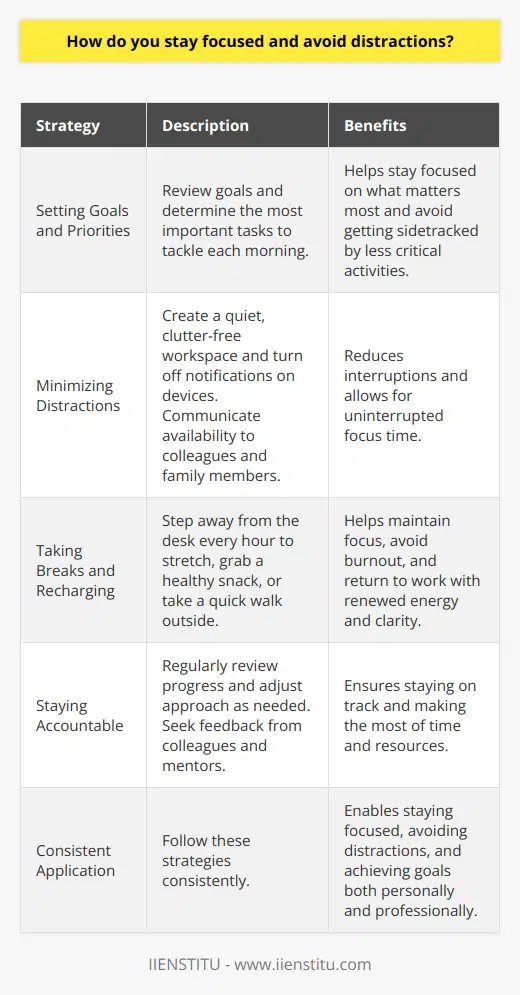
What do you do when you have multiple projects with conflicting deadlines?
When faced with multiple projects and conflicting deadlines, I prioritize tasks based on their urgency and importance. I communicate openly with my team and managers to ensure everyone is on the same page.
Assess and Prioritize
I start by evaluating each project's scope, requirements, and due dates. I then prioritize them based on their level of urgency and potential impact on the company's goals. This helps me focus my efforts on the most critical tasks first.
Break Down Tasks
I break down larger projects into smaller, manageable chunks. This allows me to tackle them more efficiently and reduces the risk of becoming overwhelmed. I set realistic milestones and deadlines for each subtask to keep myself on track.
Communicate and Collaborate
Open communication is key when juggling multiple projects. I keep my team and managers informed about my progress, any challenges I'm facing, and potential delays. I also collaborate with colleagues to share the workload and leverage their expertise when needed.
Stay Organized
To stay on top of multiple projects, I use tools like project management software and calendars. These help me visualize my tasks, deadlines, and progress in one place. I also take detailed notes during meetings to ensure I don't miss any important details.
Be Flexible and Adaptable
Despite my best efforts, unexpected challenges can arise. When this happens, I remain flexible and adapt my approach as needed. I'm not afraid to ask for help or adjust my priorities to ensure the most important tasks are completed on time.
By following these strategies, I've successfully managed multiple projects with conflicting deadlines in my previous roles. I'm confident in my ability to handle complex workloads and deliver high-quality results, even under pressure.
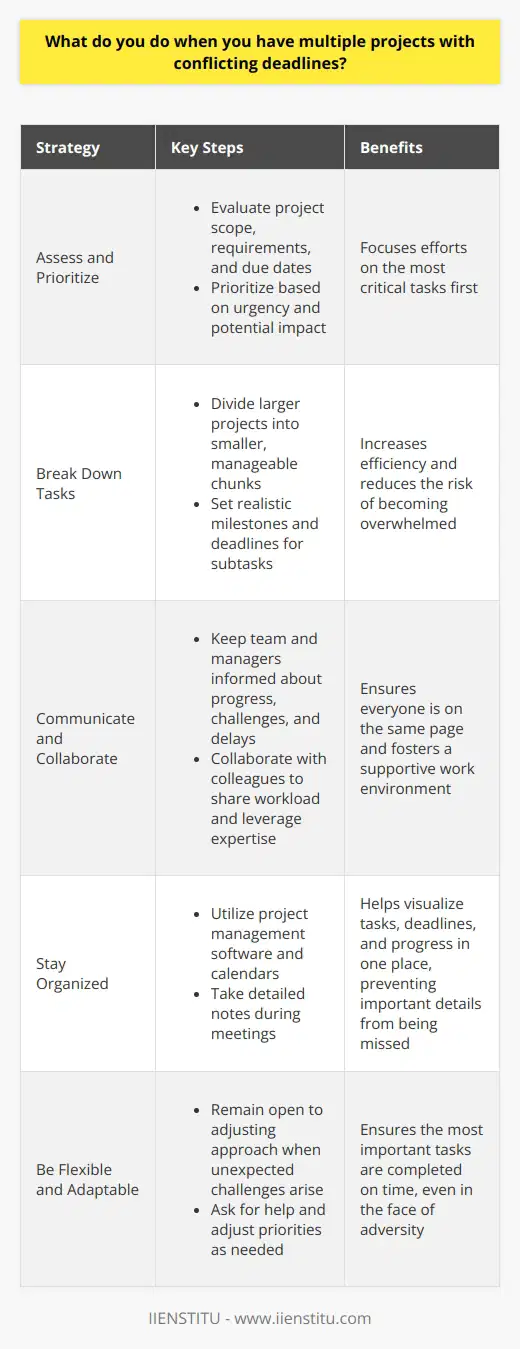
How do you ensure that you are meeting your personal and professional goals?
I ensure that I am meeting my personal and professional goals through a combination of planning, prioritization, and reflection.
Setting Clear Goals
I start by setting specific, measurable, achievable, relevant, and time-bound (SMART) goals for myself. This helps me stay focused and motivated. I write down my goals and break them down into smaller, manageable tasks.
Prioritizing Tasks
I prioritize my tasks based on their importance and urgency. I use a planner to keep track of my deadlines and commitments. This helps me stay organized and ensures that I am making progress towards my goals.
Regular Check-Ins
I schedule regular check-ins with myself to assess my progress. During these check-ins, I review my goals and adjust my plans if necessary. This helps me stay accountable and ensures that I am on track.
Seeking Feedback
I actively seek feedback from my colleagues, mentors, and supervisors. Their insights help me identify areas for improvement and growth. I use this feedback to refine my goals and strategies.
Continuous Learning
I am committed to continuous learning and professional development. I attend workshops, conferences, and training programs to expand my skills and knowledge. This helps me stay current in my field and opens up new opportunities for growth.
By following these strategies, I am able to effectively manage my time, stay focused on my goals, and achieve success in both my personal and professional life.
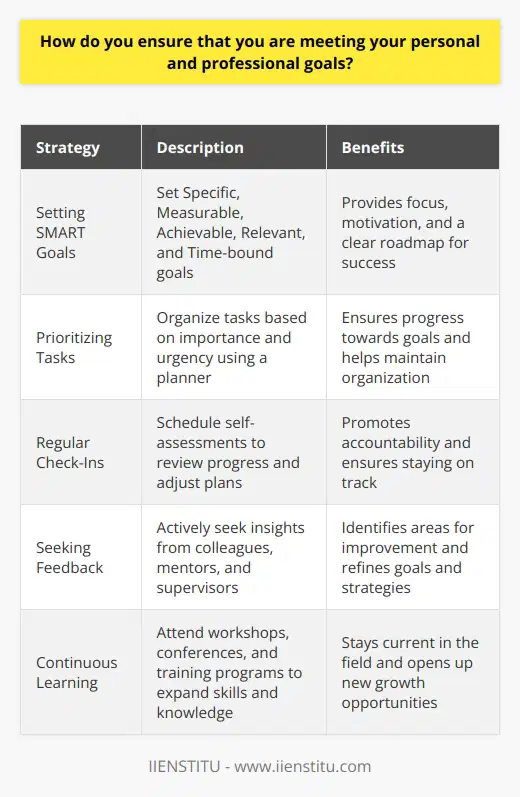
Can you give an example of how you have helped others improve their time management skills?
Throughout my career, I've helped numerous colleagues improve their time management skills. One particular instance stands out to me.
Identifying the Problem
I noticed a coworker consistently struggling to meet deadlines and feeling overwhelmed. They were clearly having trouble managing their time effectively.
Offering Assistance
I approached them and offered to help. Together, we sat down and analyzed their current time management strategies.
Implementing Solutions
We identified areas for improvement and implemented new techniques. These included prioritizing tasks, breaking projects into smaller, manageable steps, and minimizing distractions.
I also shared some of my favorite time management tools, like using a calendar app and setting reminders.
Providing Ongoing Support
Over the next few weeks, I checked in regularly to see how they were progressing. We made adjustments as needed.
Gradually, I saw a noticeable improvement in their productivity and overall sense of control over their workload.
The Results
By the end of the month, they were consistently meeting deadlines and reported feeling much less stressed at work.
It was incredibly rewarding to see the positive impact our collaboration had on their professional life. I firmly believe that effective time management is a skill that can be learned, and I'm always eager to help others develop it.
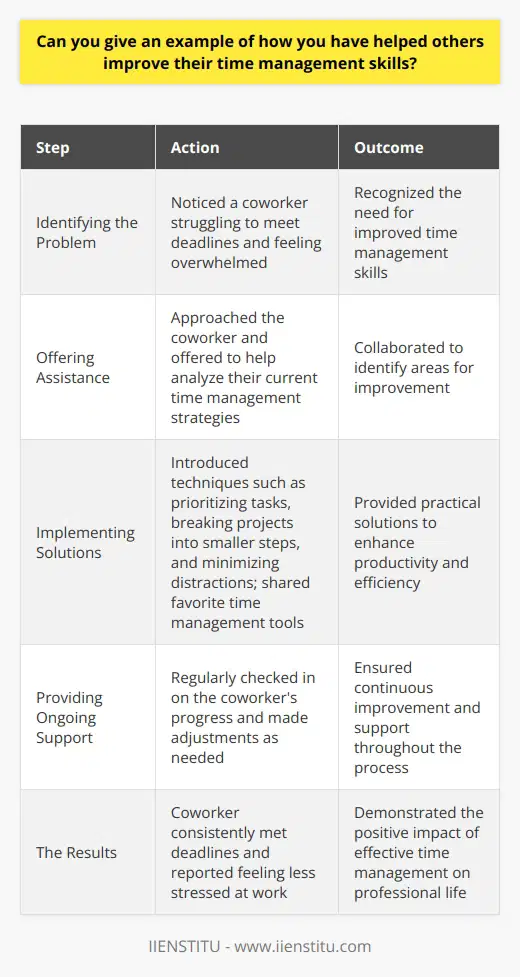
How do you handle tasks that require collaboration with others?
When it comes to collaborating with others on tasks, I find that communication is key. I always make sure to listen actively to my teammates' ideas and concerns, and I'm not afraid to speak up and share my own thoughts as well. By fostering an open and honest dialogue, we can work together more effectively and efficiently.
Building Strong Relationships
I also believe that building strong relationships with my colleagues is crucial for successful collaboration. I make an effort to get to know my teammates on a personal level, which helps create a sense of trust and camaraderie. When you have a good rapport with your coworkers, it's much easier to tackle challenges together and support each other through difficult tasks.
Staying Organized and Focused
Another important aspect of collaboration is staying organized and focused. I like to break down larger tasks into smaller, manageable steps and assign clear roles and responsibilities to each team member. This helps ensure that everyone knows what they need to do and can stay on track. I also make use of project management tools like Trello or Asana to keep everyone aligned and accountable.
Adapting to Different Working Styles
Finally, I recognize that everyone has their own unique working style, and I try to be adaptable and flexible when collaborating with others. Some people prefer to work independently, while others thrive in a more collaborative environment. By being open-minded and willing to adjust my approach as needed, I can work effectively with a wide range of personalities and work styles.
At the end of the day, I believe that successful collaboration is all about teamwork, communication, and a shared commitment to achieving our goals. By working together and supporting each other, we can overcome any challenge that comes our way.

What do you do when you have a task that you are unsure how to complete?
When faced with a task I'm unsure how to complete, I first assess the situation calmly and objectively. I break the task down into smaller, more manageable steps to identify where I need guidance.
Seeking Clarification and Resources
I'm not afraid to ask questions and seek clarification from my supervisor or colleagues. Their insights and experience can often point me in the right direction. I also utilize available resources like manuals, tutorials, or past project examples to find solutions.
Collaborating with the Team
Collaborating with team members is another effective strategy. Brainstorming ideas together can lead to innovative approaches. I remember a time when our department faced a complex project with tight deadlines. By pooling our knowledge and dividing tasks based on strengths, we delivered impressive results.
Taking Initiative and Learning
I believe in taking initiative to learn and grow. When I encounter an unfamiliar task, I see it as an opportunity to expand my skill set. I'm proactive in researching, experimenting, and seeking learning opportunities to bridge knowledge gaps.
Communicating Progress and Challenges
Throughout the process, I maintain open communication with my supervisor. I provide regular updates on my progress and promptly raise any challenges I encounter. This transparency ensures we can address issues early and keeps projects on track.
In summary, when faced with uncertainty, I stay calm, break tasks into steps, seek guidance, collaborate with others, take initiative to learn, and communicate openly. This approach has served me well in tackling complex projects and delivering quality results.
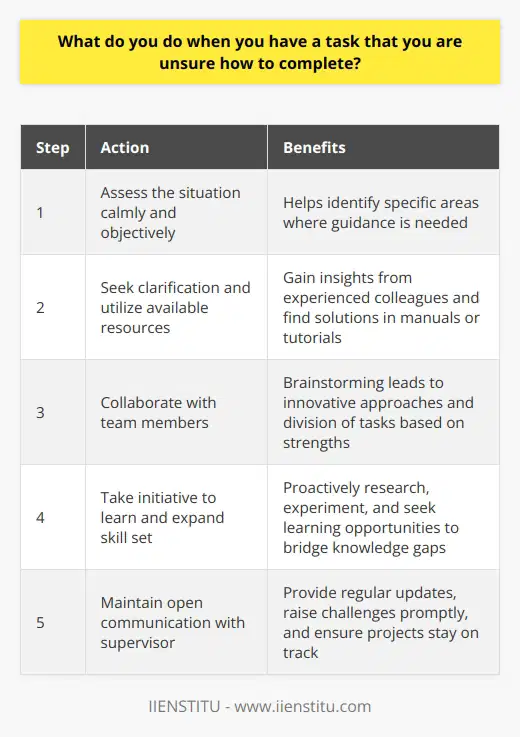
How do you ensure that you are taking breaks and avoiding burnout?
I believe that taking breaks and avoiding burnout are crucial for maintaining productivity and well-being. I make sure to schedule regular breaks throughout my workday, even if it's just for a few minutes. During these breaks, I step away from my desk and engage in activities that help me recharge, such as stretching, taking a short walk, or practicing deep breathing exercises.
Setting Boundaries
Another important aspect of avoiding burnout is setting clear boundaries between work and personal life. When I'm not at work, I make a conscious effort to disconnect from work-related tasks and focus on engaging in hobbies and spending quality time with loved ones. This helps me maintain a healthy work-life balance and prevents work-related stress from spilling over into my personal life.
Prioritizing Self-Care
I also prioritize self-care activities that promote physical and mental well-being. This includes getting enough sleep, eating a balanced diet, and engaging in regular exercise. When I take care of myself, I find that I have more energy and focus to tackle work challenges and maintain a positive outlook.
Communicating with Colleagues
Finally, I believe that open communication with colleagues and supervisors is key to avoiding burnout. When I feel overwhelmed or stressed, I don't hesitate to reach out for support or delegate tasks when necessary. By fostering a supportive and collaborative work environment, we can all work together to prevent burnout and maintain a healthy and productive team.

Can you describe a time when you had to adjust your schedule to accommodate unexpected events?
I once faced an unexpected challenge when a coworker suddenly fell ill before a critical project deadline. As the team lead, I knew I had to act fast to ensure we met our commitments.
Assessing the Situation
First, I quickly assessed which tasks were at risk and how much additional work was involved. I determined we needed to redistribute some responsibilities and put in extra hours.
Communicating with the Team
I called a meeting to explain the situation to my team. I asked for everyone's flexibility and collaboration. Together, we brainstormed how to cover the work most efficiently.
Adjusting My Own Schedule
I knew I'd have to put in the most extra time myself. I came in early, worked through lunch, and stayed late. I also worked one weekend day, despite having plans with friends.
Coordinating with Other Departments
Since the project involved multiple departments, I set up brief daily stand-up meetings. This kept everyone informed and allowed us to rapidly troubleshoot issues.
Supporting My Coworker
Although my coworker couldn't work, I made sure to check in on them. I assured them we had things under control and wished them a speedy recovery. Knowing the team "had their back" relieved a lot of their stress.
The End Result
Thanks to everyone's hard work and adaptability, we managed to complete the project on time. The client was satisfied, and my manager praised our teamwork. Personally, I was proud of how I'd stepped up as a leader.
While I certainly prefer when things go according to plan, I learned I'm quite capable of adjusting to the unexpected. Staying focused, communicating openly, and supporting one another makes almost any challenge surmountable.
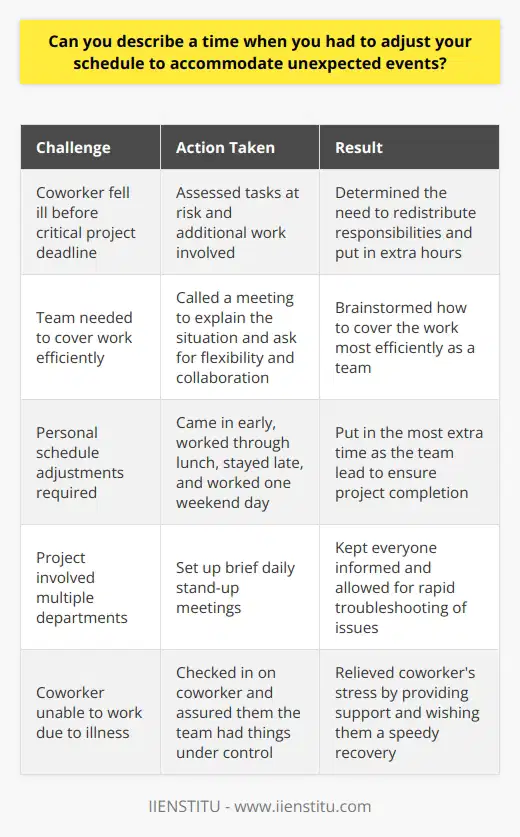
How do you prioritize tasks when everything seems equally important?
When faced with multiple tasks that seem equally important, I first take a step back and assess the bigger picture. I consider how each task aligns with the company's goals and priorities. This helps me identify which tasks have the greatest impact and urgency.
Communicate with Stakeholders
Next, I reach out to relevant stakeholders, such as my manager or colleagues, to gather their input and perspectives. Their insights help me understand the relative importance and interdependencies of each task. Through open communication, I can make more informed decisions about prioritization.
Break Down Tasks
I then break down larger tasks into smaller, manageable steps. This allows me to identify any quick wins or critical path items that need immediate attention. By tackling the most pressing parts first, I can make steady progress while ensuring nothing falls through the cracks.
Use Time Management Techniques
To stay organized and efficient, I employ various time management techniques. I use tools like task lists, calendars, and project management software to keep track of deadlines and deliverables. I also block out dedicated time slots for focused work on high-priority tasks, minimizing distractions and maximizing productivity.
Continuously Reassess and Adapt
Throughout the day, I continuously reassess my priorities based on new information or changing circumstances. I remain flexible and adaptable, ready to adjust my plan as needed. If a new urgent task arises, I quickly re-evaluate and reprioritize accordingly.
By taking a strategic approach, communicating effectively, breaking down tasks, using time management techniques, and staying adaptable, I can successfully prioritize tasks even when everything seems equally important. It's a skill I've developed through experience and one that I continue to refine to deliver the best results for the company.

What do you do when you have a task that you have been procrastinating on?
When faced with a task I've been procrastinating on, I take a step back and analyze the situation. I ask myself why I've been putting it off and identify any barriers or challenges that are holding me back. Once I have a clear understanding of the problem, I break the task down into smaller, more manageable steps.
Set a Timeline
I create a timeline for completing each step, setting realistic deadlines that hold me accountable. This helps me stay focused and motivated, knowing that I have a plan in place to tackle the task.
Eliminate Distractions
To ensure I stay on track, I eliminate any distractions that might tempt me to procrastinate further. This might mean turning off notifications on my phone, closing unnecessary tabs on my computer, or finding a quiet workspace where I can concentrate.
Celebrate Small Victories
As I make progress on the task, I celebrate each small victory along the way. This helps me maintain a positive attitude and reminds me that I am capable of overcoming challenges and achieving my goals.
Learn from the Experience
Once I've completed the task, I take time to reflect on the experience. I think about what I learned and how I can apply those lessons to future tasks. This helps me develop better strategies for managing my time and avoiding procrastination in the future.
By following these steps, I've been able to overcome procrastination and tackle even the most daunting tasks with confidence and efficiency. It's a simple but effective approach that has served me well in both my personal and professional life.
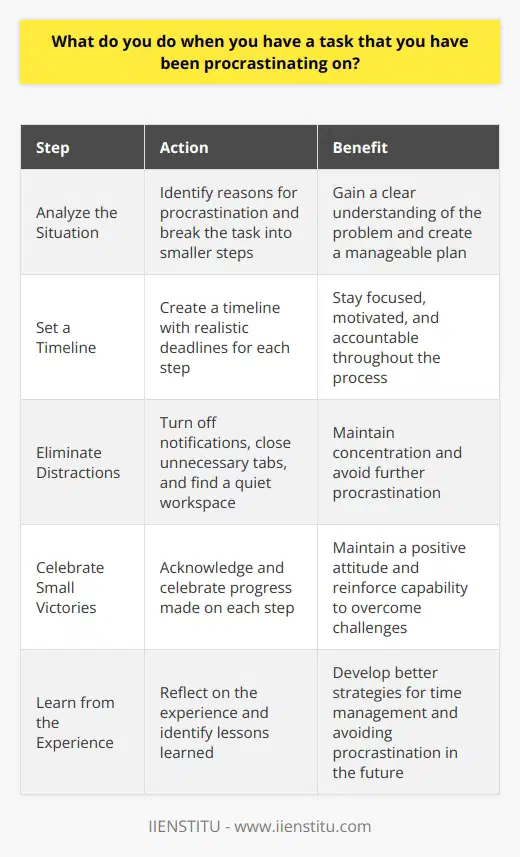
How do you ensure that you are staying organized and on track?
Staying organized and on track is crucial for me to be productive and efficient in my work. I use a combination of digital tools and physical methods to keep myself organized. Here are some of the key strategies I employ:
Prioritizing Tasks
I start each day by reviewing my to-do list and prioritizing the most important and urgent tasks. This helps me focus on what matters most and ensures that I'm making progress on my key objectives. I break down larger projects into smaller, manageable tasks to avoid feeling overwhelmed.
Using a Planner and Calendar
I rely heavily on my digital calendar to keep track of meetings, deadlines, and appointments. I also use a physical planner to jot down notes, ideas, and reminders throughout the day. Having both digital and physical tools helps me stay on top of my schedule and commitments.
Setting Realistic Goals
I believe in setting realistic and achievable goals for myself. I break down long-term goals into smaller milestones and create action plans to reach them. By setting clear targets, I can measure my progress and stay motivated along the way.
Regularly Reviewing Progress
I make it a habit to regularly review my progress and adjust my plans as needed. I set aside time each week to reflect on what I've accomplished, identify areas for improvement, and update my to-do list accordingly. This helps me stay accountable and ensures that I'm always moving forward.
Minimizing Distractions
To stay focused and productive, I try to minimize distractions in my work environment. I silence notifications on my phone and computer when I need to concentrate, and I use time-blocking techniques to dedicate specific periods to different tasks. By creating a distraction-free space, I can fully immerse myself in my work and achieve better results.
Overall, staying organized and on track requires a combination of effective strategies, self-discipline, and flexibility. By prioritizing tasks, using the right tools, setting realistic goals, regularly reviewing progress, and minimizing distractions, I'm able to stay on top of my workload and deliver high-quality results consistently.
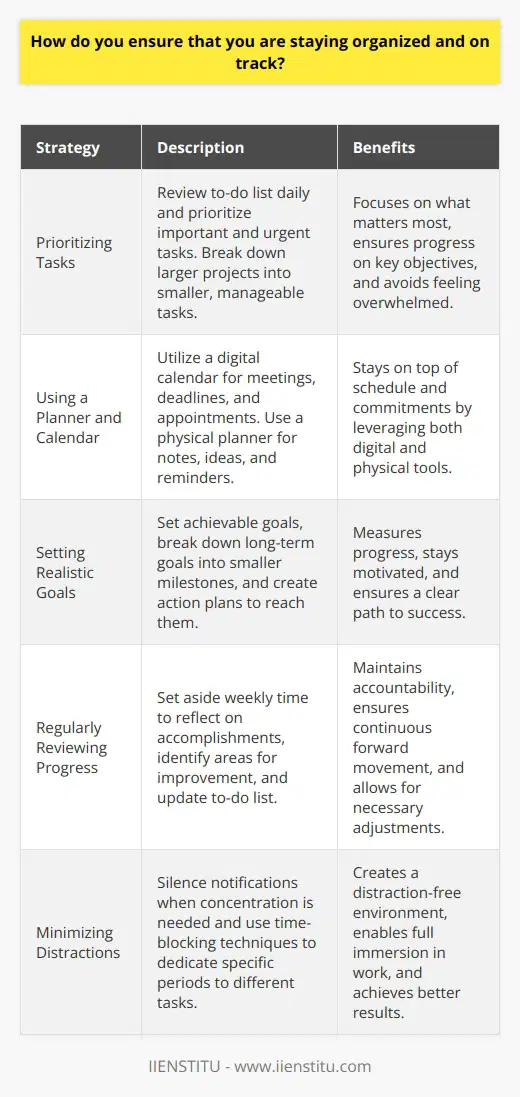
Can you give an example of a time when you used time management skills to achieve a major goal?
In my previous role as a project manager, I faced a tight deadline for a critical client deliverable. To ensure timely completion, I broke down the project into smaller, manageable tasks and allocated specific time slots for each one. I also prioritized tasks based on their importance and dependencies, focusing on the most critical ones first.
Effective Communication and Delegation
I communicated the project timeline and expectations clearly to my team members. I delegated tasks according to their strengths and expertise, ensuring everyone understood their roles and responsibilities. Regular check-ins and status updates helped me monitor progress and address any issues promptly.
Flexibility and Adaptability
Throughout the project, I remained flexible and adaptable to changes. When unexpected challenges arose, I quickly reassessed priorities and adjusted the timeline accordingly. I also identified opportunities to streamline processes and eliminate unnecessary tasks, saving valuable time.
Successful Outcome
By utilizing effective time management techniques, clear communication, and a proactive approach, I successfully led my team to deliver the project on time. The client was extremely satisfied with the quality of our work and praised our ability to meet the deadline despite the tight timeline.
This experience reinforced the importance of time management skills in achieving major goals. It taught me the value of breaking down tasks, prioritizing effectively, and maintaining open communication with team members. These skills have been invaluable in my career, allowing me to consistently deliver results under pressure.
